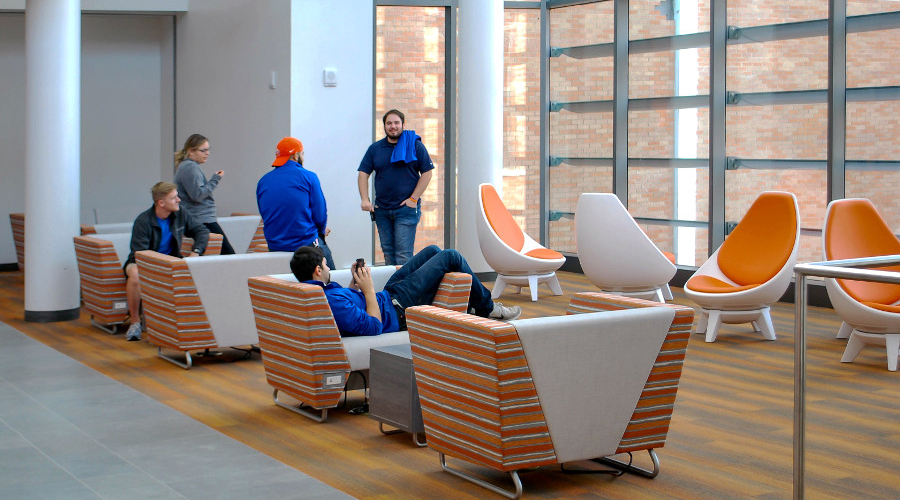Snapshot of a Snapchat Generation

A few minutes into the campus tour, in a room packed with computers and other technologies, a business executive asked to take a photo of a student simultaneously using a desktop computer, tablet, phone and laptop. He had to have the photo. Why?
The executive, who hadn’t been on a college campus in a quarter century, wanted proof of how contemporary students work and was concerned no one would believe him without an image to back the claim.
First-hand observations on college campuses can be a vital tool for businesses as they plan workplaces for a new generation of employees accustomed to studying and working in an environment with little resemblance to the corporate world.
Evolving workplace design is increasingly about fostering productivity and efficiency. Tech companies are leading the way in a move away from rows of cubicles to flexible, reconfigurable work stations and café-style working areas; elements more akin to a college campus than a corporate office.
KI and AECOM are exploring the relationship between new grads and workplace design as part of a seven-year study looking at college workspace design and its influence on the corporate world and how it can be leveraged to recruit and keep young talent.
The second phase of the study, published in 2016, discovered only about 16 percent of companies try to offer spaces designed to help ease new graduates into the workplace.
Finding new talent is one of the major hurdles facing today’s employers - the kind of thing that keeps executive up at night. One element to engaging recent graduates is studying where talent has spent the past several years working and living: college.
College students are accustomed to working in hallways on park benches, in stairwells and quiet spaces. Classroom hours and locations are flexible. A more structured corporate setting can appear too rigid, creating hiring and retention issues. Almost 90 percent of companies experience employees who struggle to adopt corporate work styles as they move from college to the business world.
Enter the campus tour.
As part of the KI and AECOM study, we wanted real-world data. KI took business leaders from Fortune 100 businesses in industries ranging from entertainment to manufacturing and finance to tour several colleges and universities to see how, and where, students worked.
One of the more telling exercises during the tour is visiting areas like student unions and lounges during peak hours and asking the invited executives if students are working or socializing. Often, it’s impossible to tell the difference: books are open, people are eating, there’s talking, but there’s also work being done.
As companies look at integrating college-influenced plans into their own designs, campus visits are one of the key tenets to the transformation. Here are a few things to contemplate when planning a campus visit:
- Visit colleges where you hire but also those that stretch and challenge your company as it relates to talent, growth and culture.
- Select two or three schools and observe students and campus design for half a day.
- Bring a cross-section of staff including human resources, design, facilities, real estate and department leaders.
- Go when school is in session to get an idea of what a “typical” day looks like.
- Compare college work styles and design to those of your business.
- Check out non-traditional spaces, they can influence planning.
Finally, don’t be afraid to take photos or video of anomalies or interesting observations. A photo of a student using four different pieces of technology at once may be just what your organization needs to kickstart a workplace design aimed at young workers.
If you’d like to tour a campus, click below to request a personal tour with the KI team.
Check out AECOM and KI’s white paper, “Collegiate Design: The New Driver for Workplace Design”.
Subscribe
Stay up to date with the latest trends and more.



